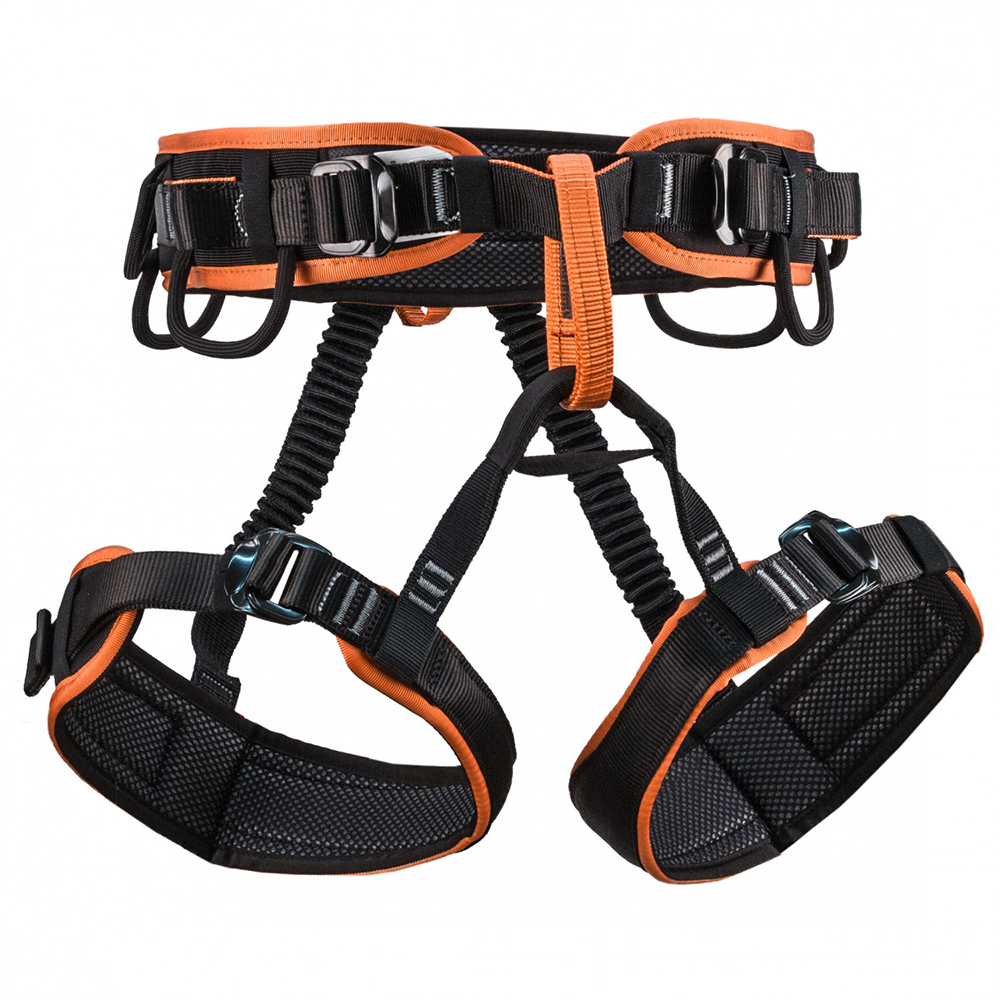Rock Climbing Harness
A rock climbing harness is one of the most basic pieces of climbing gear, but that also makes it one of the most important. Your harness is an attachment for your climbing rope and belay device.
Before you can begin climbing, you have to fit the harness on your waist. Then you knot your climbing rope to it, along with a belay device if you’re climbing with a partner. Before heading out to the rocks, inspect your harness to ensure you have a safe climb.
1.All the connections and webbing are very stable with reinforced ends;
2. Enduring buckle allows quick and easy adjust the waist and leg belt.;
3.Wider waist belt and leg loops with double thickened straps keep you comfortable while climbing;
4.Slotted buckles on chest and legs straps fasten without twisting;
5.Ideal for beginners and advanced climbers.
6.The equipment ring is wear-resistant. More equipment can be carried in the upper air,but the limit is less than 5 kg (11 lb).
How to choose the right rock climbing harness?
One of the key pieces of rock climbing kit is the harness. It’s a crucial link in the belay lifeline, wrapping our waists and thighs with padded webbing that catches us and helps catch our climbing partners in the event of a fall.
What type of climbing are you doing?
Harnesses have different features for different styles of climbing, so you can choose a harness with the features you need. You could be indoor or sport climbing; doing adventurous big-wall trad climbs or multi-pitch routes; ice climbing; or going fast and light on alpine climbs.
How should a climbing harness fit?
Fit is more than just size. Find a harness that suits your body and the clothes you’ll be climbing in. A well-fitting rock climbing harness should fit snugly above your hipbones and the “rise” (the distance between the leg loops and waist belt) should be comfortable. A harness that fits correctly cannot be pulled down over your hipbones. Whether fixed or adjustable, the leg loops should be snug but not tight.
Do you need other gear?
Check out MEC climbing harness package deals.
How to Use a Harness for Rock Climbing?
Part1: Putting on a Harness
1.Lay the harness out with the buckles and leg loops in front of you.
2.Step through the harness by putting your legs through the leg loops.
3.Pull the harness up until the waist belt is above your hips.
4.Tighten the waist loop by pulling the tail ends of the straps.
5.Double back the belt loop if yours is loose.
6.Repeat the tying and tightening process with your leg loops.
7.Feed the tail ends of the straps through the belt buckles.
Part2: Tying a Climbing Rope to a Harness
1.Measure about 3 1⁄2 in (8.9 cm) from the end of a climbing rope.
2.Twist the rope around on itself twice to form a bend.
3.Insert the working end of the rope into the loop you made.
4.Pull the working end under the belay loop on your harness.
5.Feed the rope through the bottom part of the figure 8 knot.
6.Pull the rope through the bottom loop a second time.
7.Bring the rope through the top loop to create a second knot.
8.Tie the remaining rope down with several overhand knots.
Part3: Attaching an ATC Belay Device
1.Make a bight in the middle of the climbing rope.
2.Push the bight into an ATC device.
3.Clip the ATC to the belay loop on your harness.
4.Pull and let out the rope as needed to create slack.
Q1: What is the harness called in rock climbing?
A: A sit harness consists of a waist belt and two leg loops which are normally connected in the front of the hips through a permanent webbing loop called a belay loop.
Q2: Do you need a harness for rock climbing?
A: It’s one of the first pieces of equipment a beginner will need to buy, along with shoes and a belay device. Any sort of roped climbing requires the climber and belayer to both have a climbing harness, so the only type of climbing that one can do without a harness is bouldering.
Q3: Can you belay in a full body harness?
A: It is perfectly possible to belay in a full body harness, and safe too.
Q4: Why do rock climbers need harnesses?
A: Harnesses are attached to the rope and allow you to climb safely up a rock face. They should be comfortable without being restrictive, but also fitted to stop you from falling out when on a route. Harnesses are essential for supporting you on a climb and should be looked at as an investment purchase.
Q5: How do rock climbing harnesses work?
A: Pull the whole thing up so it’s round or up by your waist. And then get the leg loops right to the top of your legs. The most important thing you do when you’re actually putting on your harness.
Professional technical engineer dedicated to guide you
According to your actual needs, choose the most reasonable overall design and planning procedures
